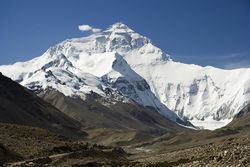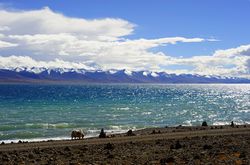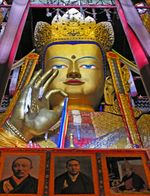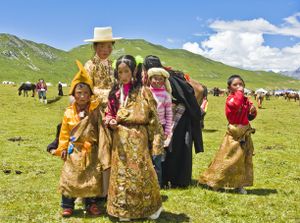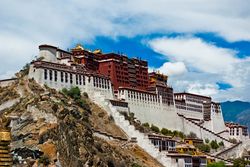منطقة التبت الذاتية
| ||||||||||||||||||||||||||||||||||||||||||||||||||||||||||||||||||||||||||||||
منطقة التبت الذاتية (Tibet Autonomous Region ؛ TAR) أو شيزانگ، المنطقة الذاتية، وتسمى التبت أو شيزانگ، [note 1] ) هي منطقة ذاتية بمستوى مقاطعة في جمهورية الصين الشعبية في جنوب غرب الصين. وتتراكب مع المنطقتين التبتيتين التقليديتين أو-تسانگ و خام.
وقد تأسست رسمياً في 1965 لتحل محل منطقة التبت، التقسيم الإداري الذي ورثته جمهورية الصين الشعبية من جمهورية الصين (ROC)، بعد نحو 5 سنوات من طرد الكاشاگ على يد السلطات الشيوعية عقب الانتفاضة التبتية 1959، وبعد نحو 13 سنة من إدماج التبت في جمهورية الصين الشعبية في 1951.
الحدود الحالية لمنطقة التبت الذاتية تأسست عموماً في القرن الثامن عشر[4] وتضم نحو نصف التبت التاريخية، أو التبت العرقية-الثقافية. تغطي منطقة التبت الذاتية 1,200,000 كم² وهي ثاني أكبر تقسيم على مستوى مقاطعة في الصين حسب المساحة، بعد شينجيانگ. بسبب تضاريسها القاسية والوعرة، فهي ذات كثافة سكانية منخفضة حيث يزيد عدد سكانها قليلاً عن 3.6 مليون نسمة، وتبلغ الكثافة السكانية 3 أشخاص للكيلومتر الواحد.
. . . . . . . . . . . . . . . . . . . . . . . . . . . . . . . . . . . . . . . . . . . . . . . . . . . . . . . . . . . . . . . . . . . . . . . . . . . . . . . . . . . . . . . . . . . . . . . . . . . . . . . . . . . . . . . . . . . . . . . . . . . . . . . . . . . . . . . . . . . . . . . . . . . . . . . . . . . . . . . . . . . . . . . .
التاريخ
Yarlung kings founded the Tibetan Empire in 618. By the end of the 8th century, the empire reached its greatest extent. After a civil war, the empire broke up in 842. The royal lineage fragmented and ruled over small kingdoms such as Guge, Maryul and Nyingma. The Mongol Empire conquered Tibet in 1244 but granted the region a degree of political autonomy. Kublai Khan later incorporated Tibetans into his Yuan empire (1271–1368). The Sakya lama Drogön Chögyal Phagpa became religious teacher to Kublai in the 1250s, and was made the head of the Tibetan region administration ح. 1264.
لايزال علماء التاريخ المعاصرة يجادلون حول طبيعة العلاقات بين التبت وأسرة مينگ الصينية (1368-1644) وما إذا كان لمينگ السيادة على التبت[5][6][7] بعد الغزو المغولي للتبت ووضع التبت تحت حكم يوان الإداري في القرنين ال13 وال14. في حين ظلت التبت رسميا محمية من الصين وتحت حكم الإداري لأسرة تشينگ (1644-1912) منذ 1720، إلا أنه تم حل سلطانها خلال 1912-1950 ووضعها ضمن الصين الأصلية نتيجة ثورة شينهاي وتركيز الحكومة المركزية القتال ضد الغزو الياباني خلال الحرب العالمية الثانية. وكانت الأجزاء أخرى من التبت العرقية والثقافية (شرق خام وأمدو) أيضا تحت إدارة حكومة الأسرة الصينية منذ منتصف القرن الثامن عشر.[8]هذه الأجزاء تتوزع اليوم بين محافظات تشينگهاي وگانسو وسيتشوان ويونان. (انظر أيضا: محافظة شيكانگ)
في عام 1950، هزم جيش التحرير الشعبي الصيني الجيش التبتي في معركة وقعت بالقرب من مدينة شامدو. وفي عام 1951، وقع ممثلو التبت إتفاق 17 نقطة مع الحكومة الشعبية المركزية الصينية تؤكد سيادة الصين على التبت وإدماج التبت. تم التصديق على الاتفاق في لاسا بعد بضعة أشهر.[9][10] على الرغم من أن اتفاق ال17 نقطة وفر لإدارة الحكم الذاتي من قبل الدالاي لاما تم إنشاء "اللجنة التحضيرية لمنطقة الحكم الذاتي في التبت" (PCART) في عام 1955 وذلك كنظام مواز للإدارة يتبع مباشرة الحكم الشيوعي. ولكن الدلاي لاما فر إلى الهند في عام 1959 وتخلى عن اتفاق 17 نقطة. ثم تأسست منطقة التبت ذاتية الحكم في عام 1965 مما جعل التبت تقسيماً إدارياً يعادل وضع المحافظة الصينية.
الجغرافيا
The Tibet Autonomous Region is located on the Tibetan Plateau, the highest region on earth. In northern Tibet elevations reach an average of over 4,572 metres (15,000 ft). Mount Everest is located on Tibet's border with Nepal.
التبت هو اقليم يقع في جنوب غرب الصين وتقع حدوده مع اقليم كشمير ونيبال والهند وبورما وتركستان الشرقية إلى جانب عدة ولايات صينية, ويعد أعلى هضبة في العالم ولذلك يسمى ب "سقف العالم". وهذا الإقليم ذو أغلبية تبتية تدين بالبوذية، كما يدين بعض سكانه بالإسلام والكاثوليكية. وهو معترف به رسميا كأقليم يحظى بحكم ذاتي تحت السيادة الصينية،و عاصمته لاهاسا (لاسا), ومساحته حوالي مليون و220 ألف كيلو متر مربع ويعد 12.8% من مساحة الصين الكلية. أما التبت بالنسبة للتبتيين فهي التبت الكبرى التي تضم التبت الصينية إضافة إلى إقليم تشينخاي ومساحات واسعة من إقليم سيتشوان ومناطق أخرى تصل مساحتها إلى 5.2 مليون كيلو متر مربع، علماً بأن مساحة الصين تصل إلى نحو 6.9 ملايين كيلو متر مربع. ومن المعروف ان الصين من الدول التي تتميز بتعددية عرقية ويضم من بينها أتراك ومنغوليون والتاى والتبتيون وهم يشكلون كلهم حوالى 5% من سكان الصين, وأما الأغلبية الباقية من السكان فهم من عرق "الهان" الذين يتميزون بمستوى ثقافى واجتماعى أفضل من باقى الجماعات العرقية والتي من أجل ذلك تشعر بالكراهية تجاه الهان وهو أحد ابعاد ازمة التبت, فالحزب الشيوعى الصينى ذو الكوادر من الهان له سجل حافل بإساءة معاملة الأقليات. أيضاً الصين بها تعددية دينية حيث توجد الكونفوشية والتاوية والبوذية والإسلام والمسيحية وهذه الديانات بدورها تنقسم إلى طوائف وبالنسبة للتبت فإن سكانها يكونون جماعة اثنيه عاشت فيها منذ قرون ويعتنقون الديانة البوذية اللامية.
الحكم
التقسيمات الادارية
The Autonomous Region is divided into seven prefecture-level divisions: five prefecture-level cities and two prefectures. It is one of only a few provincial divisions which has retained the prefecture as a unit of local government.
These in turn are subdivided into a total of 68 counties and five districts (Chengguan, Doilungdêqên, Samzhubzê, Karub, Bayi, and Nêdong).
| Administrative divisions of Tibet | |||||||||||
|---|---|---|---|---|---|---|---|---|---|---|---|

| |||||||||||
| № | Division code[11] | English name | Tibetan | Wylie transliteration Tibetan pinyin |
Chinese | Pinyin | Area in km2[12] | Population 2010[13] | Seat | Divisions[14] | |
| المديريات | Counties | ||||||||||
| 540000 | Tibet Autonomous Region |
བོད་རང་སྐྱོང་ལྗོངས། | bod rang skyong ljongs Poi Ranggyongjong |
西藏自治区 | Xīzàng Zìzhìqū | 1228400.00 | 3,002,166 | Lhasa | 6 | 68 | |
| 5 | 540100 | لهاسا | ལྷ་ས་གྲོང་ཁྱེར། | lha sa grong khyer Lhasa Chongkyir |
拉萨市 | Lāsà Shì | 29538.90 | 559,423 | Chengguan District | 2 | 6 |
| 4 | 540200 | Shigatse / Xigazê | གཞིས་ཀ་རྩེ་གྲོང་ཁྱེར། | ggzhis ka rtse grong khyer Xigazê Chongkyir |
日喀则市 | Rìkāzé Shì | 182066.26 | 703,292 | Samzhubzê District | 1 | 17 |
| 3 | 540300 | Chamdo / Qamdo | ཆབ་མདོ་གྲོང་ཁྱེར། | chab mdo grong khyer Qamdo Chongkyir |
昌都市 | Chāngdū Shì | 108872.30 | 657,505 | Karub District | 1 | 10 |
| 7 | 540400 | Nyingchi | ཉིང་ཁྲི་གྲོང་ཁྱེར། | nying khri grong khyer Nyingchi Chongkyir |
林芝市 | Línzhī Shì | 113964.79 | 195,109 | Bayi District | 1 | 6 |
| 6 | 540500 | Shannan | ལྷོ་ཁ་གྲོང་ཁྱེར། | lho kha grong khyer Lhoka Chongkyir |
山南市 | Shānnán Shì | 79287.84 | 328,990 | Nêdong District | 1 | 11 |
| 2 | 542400 | Nagqu Prefecture | ནག་ཆུ་ས་ཁུལ། | nag chu sa khul Nagqu Sakü |
那曲地区 | Nàqū Dìqū | 391816.63 | 462,382 | Nagqu County | 11 | |
| 1 | 542500 | Ngari Prefecture | མངའ་རིས་ས་ཁུལ། | mnga' ris sa khul Ngari Sakü |
阿里地区 | Ālǐ Dìqū | 296822.62 | 95,465 | Gar County | 7 | |
الديمغرافيا
| Year | Pop. | ±% |
|---|---|---|
| 1912[15] | 1٬160٬000 | — |
| 1928[16] | 372٬000 | −67.9% |
| 1936-37[17] | 372٬000 | +0.0% |
| 1947[18] | 1٬000٬000 | +168.8% |
| 1954[19] | 1٬273٬969 | +27.4% |
| 1964[20] | 1٬251٬225 | −1.8% |
| 1982[21] | 1٬892٬393 | +51.2% |
| 1990[22] | 2٬196٬010 | +16.0% |
| 2000[23] | 2٬616٬329 | +19.1% |
| 2010[24] | 3٬002٬166 | +14.7% |
| مقاطعة شيكانگ / Chuanbian SAR was established in 1923 from parts of Tibet / Lifan Yuan; dissolved in 1955 and parts were incorporated into Tibet AR. | ||
بمتوسط شخصان في الكيلومتر المربع، تُعد التبت أقل كثافة سكانية بين كل المناطق الادارية الصينية على مستوى مقاطعة، ويرجع ذلك في معظمه إلى الطبيعة الجبلية الصعبة.[25]
In 2020 the Tibetan population was three million.[26]
The ethnic Tibetans, comprising 86.0% of the population,[26] mainly adhere to Tibetan Buddhism and Bön, although there is an ethnic Tibetan Muslim community.[27] Other Muslim ethnic groups such as the Hui and the Salar have inhabited the region. There is also a tiny Tibetan Christian community in eastern Tibet. Smaller tribal groups such as the Monpa and Lhoba, who follow a combination of Tibetan Buddhism and spirit worship, are found mainly in the southeastern parts of the region.
Historically, the population of Tibet consisted of primarily ethnic Tibetans. According to tradition the original ancestors of the Tibetan people, as represented by the six red bands in the Tibetan flag, are: the Se, Mu, Dong, Tong, Dru and Ra. Other traditional ethnic groups with significant population or with the majority of the ethnic group reside in Tibet include Bai people, Blang, Bonan, Dongxiang, Han, Hui people, Lhoba, Lisu people, Miao, Mongols, Monguor (Tu people), Menba (Monpa), Mosuo, Nakhi, Qiang, Nu people, Pumi, Salar, and Yi people.
According to the Encyclopædia Britannica Eleventh Edition published between 1910 and 1911, the total population of the Tibetan capital of Lhasa, including the lamas in the city and vicinity, was about 30,000, and the permanent population also included Chinese families (about 2,000).[28]
Most Han people in the Tibet Autonomous Region (12.2% of the total population)[26] are recent migrants, because all of the Han were expelled from "Outer Tibet" (Central Tibet) following the British invasion until the establishment of the PRC.[29] Only 8% of Han people have household registration in TAR, others keep their household registration in place of origin.[30]
Tibetan scholars and exiles claim that, with the 2006 completion of the Qingzang Railway connecting the Tibet Autonomous Region to Qinghai Province, there has been an "acceleration" of Han migration into the region.[31] The Tibetan government-in-exile based in northern India asserts that the PRC is promoting the migration of Han workers and soldiers to Tibet to marginalize and assimilate the locals.[32]
. . . . . . . . . . . . . . . . . . . . . . . . . . . . . . . . . . . . . . . . . . . . . . . . . . . . . . . . . . . . . . . . . . . . . . . . . . . . . . . . . . . . . . . . . . . . . . . . . . . . . . . . . . . . . . . . . . . . . . . . . . . . . . . . . . . . . . . . . . . . . . . . . . . . . . . . . . . . . . . . . . . . . . . .
الدين
The main religion in Tibet has been Buddhism since its outspread in the 8th century AD. Before the arrival of Buddhism, the main religion among Tibetans was an indigenous shamanic and animistic religion, Bon, which now comprises a sizeable minority and influenced the formation of Tibetan Buddhism.
According to estimates from the International Religious Freedom Report of 2012, most Tibetans (who comprise 91% of the population of the Tibet Autonomous Region) are adherents of Tibetan Buddhism, while a minority of 400,000 people are followers the native Bon or folk religions which share the image of Confucius (Tibetan: Kongtse Trulgyi Gyalpo) with Chinese folk religion, though in a different light.[35][36] According to some reports, the government of China has been promoting the Bon religion, linking it with Confucianism.[37]
Most of the Han Chinese who reside in Tibet practice their native Chinese folk religion (神道; shén dào; 'Way of the Gods'). There is a Guandi Temple of Lhasa (拉萨关帝庙) where the Chinese god of war Guandi is identified with the cross-ethnic Chinese, Tibetan, Mongol and Manchu deity Gesar. The temple is built according to both Chinese and Tibetan architecture. It was first erected in 1792 under the Qing dynasty and renovated around 2013 after decades of disrepair.[38][39]
Built or rebuilt between 2014 and 2015 is the Guandi Temple of Qomolangma (Mount Everest), on Ganggar Mount, in Tingri County.[40][41]
There are four mosques in the Tibet Autonomous Region with approximately 4,000 to 5,000 Muslim adherents,[33] although a 2010 Chinese survey found a higher proportion of 0.4%.[34] There is a Catholic church with 700 parishioners, which is located in the traditionally Catholic community of Yanjing in the east of the region.[33]
حقوق الإنسان
Before the annexation of Tibet by the People's Republic of China in 1951, Tibet was ruled by a theocracy[42] and had a caste-like social hierarchy.[43] Human rights in Tibet prior to its incorporation into the People's Republic of China differed considerably from those in the modern era. Due to tight control of press in mainland China, including the Tibet Autonomous Region,[44] it is difficult to accurately determine the scope of human rights abuses.[45]
Critics of the Chinese Communist Party (CCP) say the CCP's official aim to eliminate "the three evils of separatism, terrorism and religious extremism" is used as a pretext for human rights abuses.[46] A 1992 Amnesty International report stated that judicial standards in the Tibet Autonomous Region were not up to "international standards". The report charged the CCP[47] government with keeping political prisoners and prisoners of conscience; ill-treatment of detainees, including torture, and inaction in the face of ill-treatment; the use of the death penalty; extrajudicial executions;[47][48] and forced abortion and sterilization.[49][50][51][52][53]
البلدات والقرى في التبت
برنامج الإسكان المريخ
Beginning in 2006, 280,000 Tibetans who lived in traditional villages and as nomadic herdsmen have been forcefully relocated into villages and towns. In those areas, new housing was built and existing houses were remodelled to serve a total of 2 million people. Those living in substandard housing were required to dismantle their houses and remodel them to government standards. Much of the expense was borne by the residents themselves,[54] often through bank loans. The population transfer program, which was first implemented in Qinghai where 300,000 nomads were resettled, is called "Comfortable Housing", which is part of the "Build a New Socialist Countryside" program. Its effect on Tibetan culture has been criticized by exiles and human rights groups.[54] Finding employment is difficult for relocated persons who have only agrarian skills. Income shortfalls are offset by government support programs.[55] It was announced that in 2011 that 20,000 Communist Party cadres will be placed in the new towns.[54]
الاقتصاد
| تطور الناتج المحلي الإجمالي | |
|---|---|
| Year | GDP in billions of yuan |
| 1995 | 5.61 |
| 2000 | 11.78 |
| 2005 | 24.88 |
| 2010 | 50.75 |
| 2015 | 102.64 |
| 2021 | 208.18[56] |
| Source:[57] | |
From the 1951 Seventeen Point Agreement to 2003, life expectancy in Tibet increased from thirty-six years to sixty-seven years with infant mortality and absolute poverty declining steadily.[58]
The Tibetans traditionally depended upon agriculture for survival. Since the 1980s, however, other jobs such as taxi-driving and hotel retail work have become available in the wake of Chinese economic reform. In 2011, Tibet's GDP topped 60.5 billion yuan (US$9.60 billion), nearly more than seven times as big as the 11.78 billion yuan (US$1.47 billion) in 2000. Economic growth since the beginning of the 21st century has averaged over 10 percent a year.[25]
By 2022, the GDP of the region surpassed 213 billion yuan (US$31.7 billion in nominal), while GDP per capita reached CN¥ 58,438 (US$8,688 in nominal).[59] In 2022, Tibet's GDP per capita ranked 25th highest in China, as well as higher than any South Asian country except Maldives.[60] In 2008, Chinese news media reported that the per capita disposable incomes of urban and rural residents in Tibet averaged (CN¥ 12,482 (US$1,798) and CN¥ 3,176 (US$457) respectively.[61]
While traditional agriculture and animal husbandry continue to lead the area's economy, in 2005 the tertiary sector contributed more than half of its GDP growth, the first time it surpassed the area's primary industry.[62][63] Rich reserves of natural resources and raw materials have yet to lead to the creation of a strong secondary sector, due in large part to the province's inhospitable terrain, low population density, an underdeveloped infrastructure and the high cost of extraction.[25]
The collection of caterpillar fungus (Cordyceps sinensis, known in Tibetan as Yartsa Gunbu) in late spring / early summer is in many areas the most important source of cash for rural households. It contributes an average of 40% to rural cash income and 8.5% to the Tibet Autonomous Region's GDP.[64]
The re-opening of the Nathu La pass (on southern Tibet's border with India) should facilitate Sino-Indian border trade and boost Tibet's economy.[65]
The China Western Development policy was adopted in 2000 by the central government to boost economic development in western China, including the Tibet Autonomous Region.
التعليم
There are 4 universities and 3 special colleges in Tibet,[66] including Tibet University, Tibet University for Nationalities, Tibet Tibetan Medical University, Tibet Agricultural and Animal Husbandry College, Lhasa Teachers College, Tibet Police College and Tibet Vocational and Technical College.
. . . . . . . . . . . . . . . . . . . . . . . . . . . . . . . . . . . . . . . . . . . . . . . . . . . . . . . . . . . . . . . . . . . . . . . . . . . . . . . . . . . . . . . . . . . . . . . . . . . . . . . . . . . . . . . . . . . . . . . . . . . . . . . . . . . . . . . . . . . . . . . . . . . . . . . . . . . . . . . . . . . . . . . .
السياحة
Foreign tourists were first permitted to visit the Tibet Autonomous Region in the 1980s. While the main attraction is the Potala Palace in Lhasa, there are many other popular tourist destinations including the Jokhang Temple, Namtso Lake, and Tashilhunpo Monastery.[67] Nonetheless, tourism in Tibet is still restricted for non-Chinese passport holders (including citizens of the Republic of China from Taiwan), and foreigners must apply for a Tibet Entry Permit to enter the region.
النقل
A 2019 white paper from The State Council Information Office of the People's Republic of China reported Tibet's road system has achieved a total of 118,800 km.[68]
المطارات
The civil airports in Tibet are Lhasa Gonggar Airport,[69] Qamdo Bangda Airport, Nyingchi Airport, and the Gunsa Airport.
Gunsa Airport in Ngari Prefecture began operations on 1 July 2010, to become the fourth civil airport in China's Tibet Autonomous Region.[70]
The Peace Airport for Xigazê was opened for civilian use on 30 October 2010.[71]
Announced in 2010, Nagqu Dagring Airport was expected to become the world's highest altitude airport, at 4,436 meters above sea level.[72] However, in 2015 it was reported that construction of the airport has been delayed due to the necessity to develop higher technological standards.[73]
السكك الحديدية
The Qinghai–Tibet Railway from Golmud to Lhasa was completed on 12 October 2005. It opened to regular trial service on 1 July 2006. Five pairs of passenger trains run between Golmud and Lhasa, with connections onward to Beijing, Chengdu, Chongqing, Guangzhou, Shanghai, Xining and Lanzhou. The line includes the Tanggula Pass, which, at 5,072 m (16,640 ft) above sea level, is the world's highest railway.
The Lhasa–Xigazê Railway branch from Lhasa to Xigazê was completed in 2014. It opened to regular service on 15 August 2014. The planned China–Nepal railway will connect Xigazê to Kathmandu, capital of Nepal, and is expected to be completed around 2027.[74]
The construction of the Sichuan–Tibet Railway began in 2015. The line is expected to be completed around 2025.[75]
السياحة
انظر أيضاً
- China Tibetology Research Center
- History of Tibet (1950–present)
- List of prisons in the Tibet Autonomous Region
- List of universities and colleges in Tibet
- Tibet Area, Republic of China
- Tibetan Independence Movement
- Sinicization of Tibet
- Shigatse Photovoltaic Power Plant
الهامش
- ^ "西藏概况(2007年)" [Overview of Tibet (2007)] (in الصينية). People's Government of Tibet Autonomous Region. 11 September 2008. Retrieved 18 December 2015.
- ^ "National Data". National Bureau of Statistics of China. Retrieved 18 December 2015.
- ^ 《2013中国人类发展报告》 (PDF) (in الصينية). United Nations Development Programme China. 2013. Retrieved 14 May 2014.
- ^ "What is Tibet? – Fact and Fancy", Excerpt from Goldstein, Melvyn, C. (1994). Change, Conflict and Continuity among a Community of Nomadic Pastoralist: A Case Study from Western Tibet, 1950–1990. pp. 76–87.
{{cite book}}: CS1 maint: multiple names: authors list (link) - ^ Wylie (2003), 470.
- ^ Wang & Nyima (1997), 1–40.
- ^ Laird (2006), 106–7.
- ^ Grunfeld, A. Tom, The Making of Modern Tibet, M.E. Sharpe, p245.
- ^ Gyatso, Tenzin, Dalai Lama XIV, interview, 25 July 1981.
- ^ Goldstein, Melvyn C., A History of Modern Tibet, 1913–1951, University of California Press, 1989, p. 812-813.
- ^ "中华人民共和国县以上行政区划代码". 中华人民共和国民政部.
- ^ 深圳市统计局 [Shenzhen City Bureau of Statistics]. 《深圳统计年鉴2014》. 中国统计出版社 [China Statistics Press]. Retrieved 2015-05-29.
{{cite book}}:|work=ignored (help) - ^ Population Census Office of the State Council; compiled by Population and Employment Statistics Department, National Bureau of Statistics (2012). Tabulation on the 2010 Population Census of the People's Republic of China by Township (1st ed.). Beijing: China Statistics Press. ISBN 978-7-5037-6660-2.
{{cite book}}:|access-date=requires|url=(help) - ^ 中华人民共和国民政部 (August 2014). 《中国民政统计年鉴2014》. China Statistics Press. ISBN 978-7-5037-7130-9.
- ^ "1912年中国人口". Retrieved 6 March 2014.
- ^ "1928年中国人口". Retrieved 6 March 2014.
- ^ "1936-37年中国人口". Retrieved 6 March 2014.
- ^ "1947年全国人口". Retrieved 6 March 2014.
- ^ "中华人民共和国国家统计局关于第一次全国人口调查登记结果的公报". المكتب الوطني للإحصاء في الصين.
- ^ "第二次全国人口普查结果的几项主要统计数字". المكتب الوطني للإحصاء في الصين.
- ^ "中华人民共和国国家统计局关于一九八二年人口普查主要数字的公报". المكتب الوطني للإحصاء في الصين.
- ^ "中华人民共和国国家统计局关于一九九〇年人口普查主要数据的公报". المكتب الوطني للإحصاء في الصين.
- ^ "现将2000年第五次全国人口普查快速汇总的人口地区分布数据公布如下". المكتب الوطني للإحصاء في الصين.
- ^ "Communiqué of the National Bureau of Statistics of People's Republic of China on Major Figures of the 2010 Population Census". المكتب الوطني للإحصاء في الصين.
- ^ أ ب ت China Economy @ China Perspective. Thechinaperspective.com. Retrieved on 18 July 2013.
- ^ أ ب ت "How Much Does Beijing Control the Ethnic Makeup of Tibet?". ChinaFile (in الإنجليزية). 2021-09-02. Retrieved 2023-05-08.
- ^ Hannue, Dialogues Tibetan Dialogues Han
- ^
 Chisholm, Hugh, ed. (1911). . دائرة المعارف البريطانية. Vol. 16 (eleventh ed.). Cambridge University Press. p. 531.
Chisholm, Hugh, ed. (1911). . دائرة المعارف البريطانية. Vol. 16 (eleventh ed.). Cambridge University Press. p. 531. {{cite encyclopedia}}: Cite has empty unknown parameter:|coauthors=(help) - ^ Grunfeld, A. Tom (1996). The Making of Modern Tibet. East Gate Books. pp. 114–119.
- ^ 西藏自治区常住人口超过300万. Xizang gov. Xizang gov. Archived from the original on 16 February 2013. Retrieved 6 May 2011.
- ^ Johnson, Tim (28 March 2008). "Tibetans see 'Han invasion' as spurring violence | McClatchy". Mcclatchydc.com. Archived from the original on 15 November 2009. Retrieved 11 October 2011.
- ^ "Population Transfer Programmes". Central Tibetan Administration. 2003. Archived from the original on 30 July 2010. Retrieved 29 July 2010.
- ^ أ ب ت Internazional Religious Freedom Report 2012 by the US government. p. 20: «Most ethnic Tibetans practice Tibetan Buddhism, although a sizeable minority practices Bon, an indigenous religion, and very small minorities practice Islam, Catholicism, or Protestantism. Some scholars estimate that there are as many as 400,000 Bon followers across the Tibetan Plateau. Scholars also estimate that there are up to 5,000 ethnic Tibetan Muslims and 700 ethnic Tibetan Catholics in the TAR.»
- ^ أ ب Min Junqing. The Present Situation and Characteristics of Contemporary Islam in China. JISMOR, 8. 2010 Islam by province, page 29. Data from: Yang Zongde, Study on Current Muslim Population in China, Jinan Muslim, 2, 2010.
- ^ Te-Ming TSENG; Shen-Yu LIN (December 2007). 《臺灣東亞文明研究學刊》第4卷第2期(總第8期) [The Image of Confucius in Tibetan Culture] (PDF). National Taiwan University. pp. 169–207. Archived from the original (PDF) on 4 March 2016.
- ^ Shenyu Lin. The Tibetan Image of Confucius Archived 13 سبتمبر 2017 at the Wayback Machine. Revue d’Etudes Tibétaines.
- ^ China-Tibet Online: Confucius ruled as a "divine king" in Tibet[dead link]. 4 November 2014
- ^ World Guangong Culture: Lhasa, Tibet: Guandi temple was inaugurated Archived 4 مارس 2016 at the Wayback Machine.
- ^ China-Tibet Online: Tibet's largest Guandi Temple gets repaired[dead link]. 13 March 2013
- ^ World Guangong Culture: Dingri, Tibet: Cornerstone Laying Ceremony being Grandly Held for the Reconstruction of Qomolangma Guandi Temple Archived 7 نوفمبر 2017 at the Wayback Machine.
- ^ World Guangong Culture: Wuhan, China: Yang Song Meets Cui Yujing to Discuss Qomolangma Guandi Temple Archived 4 مارس 2016 at the Wayback Machine.
- ^ Samten G. Karmay, Religion and Politics: commentary Archived 2016-03-05 at the Wayback Machine, September 2008: "from 1642 the Ganden Potrang, the official seat of the government in Drepung Monastery, came to symbolize the supreme power in both the theory and practice of a theocratic government. This was indeed a political triumph that Buddhism had never known in its history in Tibet."
- ^ Fjeld, Heidi (2003). Commoners and Nobles:Hereditary Divisions in Tibet. Nordic Institute of Asian Studies. p. 5. ISBN 9788791114175.
- ^ Regions and territories: Tibet bbc http://news.bbc.co.uk/2/hi/asia-pacific/country_profiles/4152353.stm Archived 2011-04-22 at the Wayback Machine
- ^ US State Department, Bureau of Democracy, Human Rights, and Labor, 2008 Human Rights Report: China (includes Tibet, Hong Kong, and Macau), February 25, 2009
- ^ Simon Denyer, China cracks down on aggrieved party cadres in Xinjiang and Tibet Archived 2016-12-29 at the Wayback Machine, The Guardian, 8 December 2015.
- ^ أ ب Amnesty International, Amnesty International: "China – Amnesty International's concerns in Tibet" Archived 2009-09-12 at the Wayback Machine, Secretary-General's Report: Situation in Tibet, E/CN.4/1992/37
- ^ "Amnesty International Documents". Hrweb.org. Archived from the original on 15 March 2012. Retrieved 2012-12-09.
- ^ Goldstein, Melvyn; Cynthia, Beall (March 1991). "China's Birth Control Policy in the Tibet Autonomous Region". Asian Survey. 31 (3): 285–303. doi:10.2307/2645246. JSTOR 2645246.
- ^ "Human Rights Violations in Tibet". Human Rights Watch. 13 June 2000.
- ^ "Database of NGO Reports presented to the UN Committee on the Rights of the Child" (PDF). Archive. Archived from the original (PDF) on 19 January 2012.
- ^ "China must urgently address rights violations in Tibet – UN senior official". UN News. 2 November 2012.
- ^ "European Parliament resolution of 10 April 2008 on Tibet". Publications Office of the EU. 10 April 2008.
- ^ أ ب ت "They Say We Should Be Grateful". Human Rights Watch (in الإنجليزية). 2013-06-27. Retrieved 2020-08-14.
- ^ Jacobs, Andrew (27 June 2013). "Rights Report Faults Mass Relocation of Tibetans". The New York Times. Archived from the original on 27 June 2013. Retrieved 28 June 2013.
- ^ "2021年西藏GDP达2080.17亿元 同比增长6.7%_中国经济网——国家经济门户". district.ce.cn. Retrieved 2023-02-18.
- ^ Historical GDP of Provinces "Home – Regional – Annual by Province" (Press release). China NBS. 31 January 2020. Retrieved 31 January 2020.
- ^ Lin, Chun (2006). The transformation of Chinese socialism. Durham [N.C.]: Duke University Press. p. 103. ISBN 978-0-8223-3785-0. OCLC 63178961.
- ^ خطأ استشهاد: وسم
<ref>غير صحيح؛ لا نص تم توفيره للمراجع المسماةdata2022 - ^ International Monetary Fund. "World Economic Outlook Database, April 2023". International Monetary Fund.
- ^ "Tibetans report income rises". news.nen.com.cn. Archived from the original on 21 July 2011. Retrieved 11 October 2011.
- ^ "Xinhua – Per capita GDP tops $1,000 in Tibet". news.xinhuanet.com. Xinhua. 31 January 2006. Archived from the original on 9 June 2011. Retrieved 11 October 2011.
- ^ "Tibet posts fixed assets investment rise". news.xinhuanet.com. Xinhua. 31 January 2006. Archived from the original on 9 June 2011. Retrieved 11 October 2011.
- ^ Winkler D. 2008 Yartsa gunbu (Cordyceps sinenis) and the fungal commodification of rural Tibet. Economic Botany 62.3. See also Hannue, Dialogues Tibetan Dialogues Han
- ^ Maseeh Rahman in New Delhi (19 June 2006). "China and India to trade across Himalayas | World news". The Guardian. London. Retrieved 11 October 2011.
- ^ "全国高等学校名单 – 中华人民共和国教育部政府门户网站". www.moe.gov.cn. Retrieved 2022-06-18.
- ^ Birgit Zotz, Destination Tibet. Hamburg: Kovac 2010, ISBN 978-3-8300-4948-7 d-nb
.info /999787640 /04 "Archived copy". Archived from the original on 17 January 2012. Retrieved 27 October 2011. {{cite web}}: CS1 maint: archived copy as title (link) CS1 maint: bot: original URL status unknown (link) - ^ "Full Text: Tibet Since 1951: Liberation, Development and Prosperity". english.www.gov.cn. Retrieved 2022-12-01.
- ^ "Gongkhar Airport in Tibet enters digital communication age". Xinhua News Agency. 12 مايو 2009. Archived from the original on 15 ديسمبر 2010. Retrieved 12 ديسمبر 2010.
- ^ "Tibet's fourth civil airport opens". Xinhua News Agency. 1 July 2010. Archived from the original on 14 December 2010. Retrieved 11 December 2010.
- ^ "Tibet to have fifth civil airport operational before year end 2010". Xinhua News Agency. 26 July 2010. Archived from the original on 15 December 2010. Retrieved 12 December 2010.
- ^ "World's highest-altitude airport planned on Tibet". news.xinhuanet.com. Xinhua News Agency. 12 January 2010. Archived from the original on 15 December 2010. Retrieved 12 December 2010.
- ^ "China to stop building extremely high plateau airports". www.chinadaily.com.cn. China Daily. 24 April 2015. Retrieved 17 September 2021.
- ^ Giri, A; Giri, S (24 August 2018). "Nepal, China agree on rail study". The Kathmandu Post. Archived from the original on 22 September 2018. Retrieved 22 September 2018.
- ^ Chu. "China Approves New Railway for Tibet". english.cri.cn. CRI. Archived from the original on 9 November 2014. Retrieved 9 November 2014.
للاستزادة
- Hannue, Dialogues Tibetan Dialogues Han, travelogue from Tibet – by a woman who's been travelling around Tibet for over a decade, ISBN 978-988-97999-3-9
- Sorrel Wilby, Journey Across Tibet: A Young Woman's 1900-Mile Trek Across the Rooftop of the World, Contemporary Books (1988), hardcover, 236 pages, ISBN 0-8092-4608-2.
- Hillman, Ben, ‘China’s Many Tibets: Diqing as a model for ‘development with Tibetan characteristics?’ Asian Ethnicity, Vol. 11, No. 2, June 2010, pp 269–277.
وصلات خارجية
- Tibet Autonomous Region official website
- Economic profile for Tibet Autonomous Region at HKTDC
 Tibet Autonomous Region travel guide from Wikivoyage
Tibet Autonomous Region travel guide from Wikivoyage
قالب:Tibetan autonomy in the People's Republic of China
خطأ استشهاد: وسوم <ref> موجودة لمجموعة اسمها "note"، ولكن لم يتم العثور على وسم <references group="note"/>
- CS1 الصينية-language sources (zh)
- CS1 uses الصينية-language script (zh)
- CS1 errors: periodical ignored
- CS1 errors: access-date without URL
- مقالات المعرفة المحتوية على معلومات من دائرة المعارف البريطانية طبعة 1911
- Articles with dead external links from December 2017
- CS1 maint: bot: original URL status unknown
- Short description is different from Wikidata
- Articles containing صينية-language text
- Pages using infobox settlement with missing country
- Articles with hatnote templates targeting a nonexistent page
- Articles containing Chinese-language text
- منطقة التبت الذاتية
- التبت
- غرب الصين
- مناطق ذاتية في الصين
- تأسيسات 1965 في الصين
- دول وأراضي تأسست في 1965



